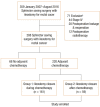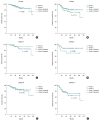Clinical Outcomes of Ileostomy Closure According to Timing During Adjuvant Chemotherapy After Rectal Cancer Surgery
- PMID: 31487766
- PMCID: PMC6732323
- DOI: 10.3393/ac.2018.10.18.1
Clinical Outcomes of Ileostomy Closure According to Timing During Adjuvant Chemotherapy After Rectal Cancer Surgery
Abstract
Purpose: No guidelines exist detailing when to implement a temporary ileostomy closure in the setting of adjuvant chemotherapy following sphincter-saving surgery for rectal cancer. The aim of this study was to evaluate the clinical and oncological outcomes of ileostomy closure during adjuvant chemotherapy in patients with curative resection of rectal cancer.
Methods: This retrospective study investigated 220 patients with rectal cancer undergoing sphincter-saving surgery with protective loop ileostomy from January 2007 to August 2016. Patients were divided into 2 groups: group 1 (n = 161) who underwent stoma closure during adjuvant chemotherapy and group 2 (n = 59) who underwent stoma closure after adjuvant chemotherapy.
Results: No significant differences were observed in operative time, blood loss, postoperative hospital stay, or postoperative complications in ileostomy closure between the 2 groups. No difference in overall survival (P = 0.959) or disease-free survival (P = 0.114) was observed between the 2 groups.
Conclusion: Ileostomy closure during adjuvant chemotherapy was clinically safe, and interruption of chemotherapy due to ileostomy closure did not change oncologic outcomes.
Keywords: Adjuvant chemotherapy; Ileostomy; Rectal neoplasms.
Conflict of interest statement
No potential conflict of interest relevant to this article was reported.
Figures


Similar articles
-
Clinical Outcomes of Ileostomy Closure during versus after Adjuvant Chemotherapy in Patients with Rectal Cancer.Can J Gastroenterol Hepatol. 2024 Mar 20;2024:2410643. doi: 10.1155/2024/2410643. eCollection 2024. Can J Gastroenterol Hepatol. 2024. PMID: 38550348 Free PMC article.
-
Clinical Outcomes of Ileostomy Closure before Adjuvant Chemotherapy after Rectal Cancer Surgery: An Observational Study from a Chinese Center.Gastroenterol Res Pract. 2021 Jul 13;2021:5592721. doi: 10.1155/2021/5592721. eCollection 2021. Gastroenterol Res Pract. 2021. PMID: 34335738 Free PMC article.
-
Advantages of Early Preventive Ileostomy Closure after Total Mesorectal Excision Surgery for Rectal Cancer: An Institutional Retrospective Study of 123 Consecutive Patients.Dig Surg. 2017;34(4):305-311. doi: 10.1159/000452676. Epub 2016 Dec 10. Dig Surg. 2017. PMID: 27941329
-
Meta-analysis of temporary loop ileostomy closure during or after adjuvant chemotherapy following rectal cancer resection: the dilemma remains.Int J Colorectal Dis. 2019 Jul;34(7):1151-1159. doi: 10.1007/s00384-019-03321-2. Epub 2019 May 25. Int J Colorectal Dis. 2019. PMID: 31129697
-
The influence of diverting loop ileostomy vs. colostomy on postoperative morbidity in restorative anterior resection for rectal cancer: a systematic review and meta-analysis.Langenbecks Arch Surg. 2019 Mar;404(2):129-139. doi: 10.1007/s00423-019-01758-1. Epub 2019 Feb 12. Langenbecks Arch Surg. 2019. PMID: 30747281
Cited by
-
Comparison of clinical outcomes of stoma reversal during versus after chemotherapy for rectal cancer patients.Langenbecks Arch Surg. 2023 Jul 12;408(1):274. doi: 10.1007/s00423-023-03014-z. Langenbecks Arch Surg. 2023. PMID: 37438486
-
Clinical Outcomes of Ileostomy Closure during versus after Adjuvant Chemotherapy in Patients with Rectal Cancer.Can J Gastroenterol Hepatol. 2024 Mar 20;2024:2410643. doi: 10.1155/2024/2410643. eCollection 2024. Can J Gastroenterol Hepatol. 2024. PMID: 38550348 Free PMC article.
-
Clinical Outcomes of Ileostomy Closure before Adjuvant Chemotherapy after Rectal Cancer Surgery: An Observational Study from a Chinese Center.Gastroenterol Res Pract. 2021 Jul 13;2021:5592721. doi: 10.1155/2021/5592721. eCollection 2021. Gastroenterol Res Pract. 2021. PMID: 34335738 Free PMC article.
-
Impact of a defunctioning ileostomy and time to stoma closure on bowel function after low anterior resection for rectal cancer: a systematic review and meta-analysis.Tech Coloproctol. 2021 Jul;25(7):751-760. doi: 10.1007/s10151-021-02436-5. Epub 2021 Apr 1. Tech Coloproctol. 2021. PMID: 33792822 Free PMC article.
-
Prophylactic effect of retromuscular mesh placement during loop ileostomy closure on incisional hernia incidence-a multicentre randomised patient- and observer-blind trial (P.E.L.I.O.N trial).Trials. 2023 Feb 1;24(1):76. doi: 10.1186/s13063-023-07089-3. Trials. 2023. PMID: 36726155 Free PMC article. Clinical Trial.
References
-
- Hüser N, Michalski CW, Erkan M, Schuster T, Rosenberg R, Kleeff J, et al. Systematic review and meta-analysis of the role of defunctioning stoma in low rectal cancer surgery. Ann Surg. 2008;248:52–60. - PubMed
-
- Tan WS, Tang CL, Shi L, Eu KW. Meta-analysis of defunctioning stomas in low anterior resection for rectal cancer. Br J Surg. 2009;96:462–72. - PubMed
-
- Giannakopoulos GF, Veenhof AA, van der Peet DL, Sietses C, Meijerink WJ, Cuesta MA. Morbidity and complications of protective loop ileostomy. Colorectal Dis. 2009;11:609–12. - PubMed
-
- Akesson O, Syk I, Lindmark G, Buchwald P. Morbidity related to defunctioning loop ileostomy in low anterior resection. Int J Colorectal Dis. 2012;27:1619–23. - PubMed
LinkOut - more resources
Full Text Sources

